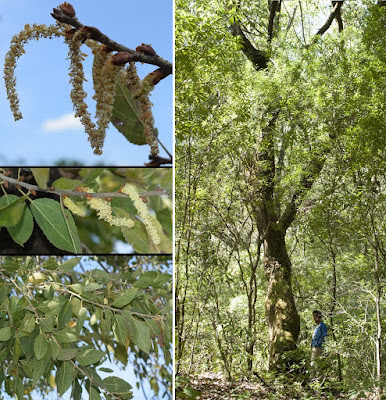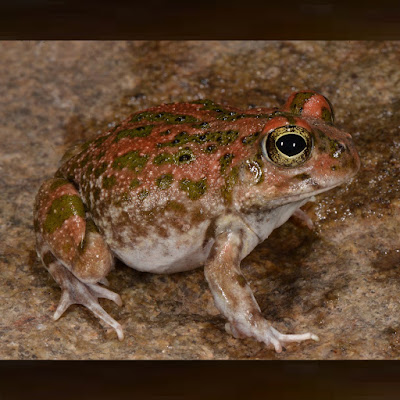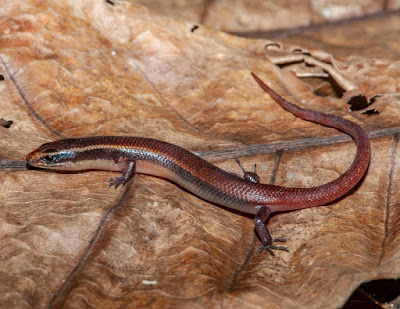[Most Recent Entries] [Calendar View]
Friday, May 24th, 2019
| Time | Event | ||
| 3:53p | [PaleoEntomology • 2019] Notaepytus quisqueya • A New Species of Notaepytus Skelley, 2009 (Coleoptera: Erotylidae: Tritomini) from Dominican Amber
Notaepytus quisqueya sp. nov. (Erotylidae: Erotylinae: Tritomini), is described here from Dominican amber and is the second amber fossil description for the family from the West Indies (Hispaniola). An emended key and a checklist to all known species of Notaepytus are presented. Key words: Cucujoidea, Greater Antilles, fossil, checklist, key, Miocene Notaepytus Skelley, 2009 Besides being found on Hispaniola, the fossil species possesses the combination of diagnostic characters for the genus Notaepytus: triangular mental plate, femora lacking posterior marginal bead, antennomere IX longer than wide and triangularly narrowed, terminal antennomere distinctly pale, and body brown to black with a color pattern. Notaepytus quisqueya Keller and Skelley, new species Diagnosis. Notaepytus quisqueya is readily distinguished from other species in the genus by the circular, black macula on the disc of the pronotum (Fig. 1a), the distinctly triangular and flattened antennomere VIII (Fig. 1b, arrow), and the distinct elytral marks (Fig. 1c). ... Etymology. The island of Hispaniola was called Quisqueya by the aboriginal Taíno people. We here apply Quisqueya to this species as a noun in apposition. Oliver Keller and Paul E. Skelley. 2019. A New Species of Notaepytus Skelley, 2009 (Coleoptera: Erotylidae: Tritomini) from Dominican Amber. Zootaxa. 4609(1); 191–195. DOI: 10.11646/zootaxa.4609.1.12 Aquí se describe Notaepytus quisqueya sp. nov. (Erotylidae: Erotylinae: Tritomini), obtenido de ámbar Dominicano. Es la segunda descripción de un fósil en ámbar en esta familia para las Indias Occidentales (Hispaniola). Se presentan una clave modificada y una lista de verificación para todas las especies conocidas de Notaepytus. Palabras clave: Cucujoidea, Antillas Mayores, fósiles, lista de verificación, clave, Mioceno | ||
| 3:54p | [Botany • 2019] Populus primaveralepensis (Salicaceae, Malpighiales) • A New Species of White Poplar from the Bosque La Primavera Biosphere Reserve in western Mexico
Abstract Populus primaveralepensis A.Vázquez, Muñiz-Castro & Zuno sp. nov., a new species from relict gallery cloud forest in Bosque La Primavera Biosphere Reserve (Mexico), is described and illustrated. The new species belongs to P. subsect. Tomentosae Hart., and is morphologically similar to P. luziarum A.Vázquez, Muñiz-Castro & Padilla-Lepe, but differs from it in having taller trees without root suckers, white and ringed young stems and branches, a branching angle of ca 45º, leaves with higher blade to petiole ratio, leafs frequently elliptic or ovate to widely ovate (vs widely ovate to ovatedeltoid), denser inflorescences, and shorter capsules. The conservation status of the species was assessed as Critically Endangered (CR). Keywords. Mexico, Populus luziarum, Populus simaroa, Populus sect. Aigeiros, Salicaceae. Class Magnoliopsida Brongn. Order Malpighiales Juss. ex Bercht. & J.Presl Family Salicaceae Mirb. Genus Populus L. Section Populus Subsection Tomentosae Hart. Populus primaveralepensis A.Vázquez, Muñiz-Castro & Zuno sp. nov. Differential diagnosis Populus primaveralepensis sp. nov. is morphologically close to P. luziarum, but it differs from the latter in possessing various qualitative and quantitative characters, such as having taller trees with nonsoboliferous habit, branching angle of ca 45º with white and ringed bark, and leaves with higher blade to petiole ratio (large leaves with petioles 2.9–3.9 vs 5.4–6 cm long, leaf blades frequently elliptic or ovate to widely ovate vs widely ovate to ovate-deltoid, 17–18.5 vs 15.5–16 cm long, inflorescences dense vs sparse, and shorter capsules, 1.0–1.8 vs 2.0–2.5 mm (Table 1). .... Etymology: The epithet honors the collective conservation accomplishments at Bosque La Primavera for its twelfth anniversary as a MaB–UNESCO Biosphere Reserve as well as the biologist Jesús Padilla Lepe, a young and enthusiastic botanical explorer graduated from the Universidad de Guadalajara who discovered the species. Ethnobotany: The species is locally known as “álamo”. There is no available information on the use of the species in Jalisco; however, sometimes it is kept as a shade tree for cows. Like other species in the genus Populus, P. primaveralepensis sp. nov. is a potential source of cellulose fibers, and can be used as an ornamental tree, or for restoration of watersheds in central Jalisco. J. Antonio Vázquez-García, Miguel Ángel Muñiz-Castro, Rosa Elena Martínez-González, Gregorio Nieves-Hernández, María Guadalupe Pulido-Ávila, Gerardo Hernández-Vera and Osvaldo Zuno Delgadillo. 2019. Populus primaveralepensis sp. nov. (Salicaceae, Malpighiales), A New Species of White Poplar from the Bosque La Primavera Biosphere Reserve in western Mexico. European Journal of Taxonomy. 498: 1–16. DOI: 10.5852/ejt.2019.498 | ||
| 4:05p | [Herpetology • 2019] Tomopterna branchi • A New Sand Frog (Pyxicephalidae: Tomopterna) from Namaqualand, South Africa
Abstract Tomopterna branchi sp. nov. is described from Namaqualand, South Africa. It differs from all other Tomopterna species by advertisement call, 16S rRNA sequence and consistent differences in adult morphology. The tadpole is similar to that of Tomopterna cryptotis. Haplotype networks of 16S and the nuclear tyr gene show that it is distinct from T. delalandii, with which it has been confused. A phylogeny of the genus, excluding the little-known T. monticola, shows that the new species is basal to a clade that includes T. delalandii and six other species. We extend the known range of T. damarensis to southern Namibia, and correct the identification of some GenBank material. Keywords: Amphibia, Namaqualand, sand frogs, new species, Tomopterna branchi sp. nov., haplotype network, phylogeny, Tomopterna damarensis distribution Lyle Wilson and Alan Channing. 2019. A New Sand Frog from Namaqualand, South Africa (Pyxicephalidae: Tomopterna). Zootaxa. 4609(2); 225–246. DOI: 10.11646/zootaxa.4609.2.2 | ||
| 4:18p | [Herpetology • 2019] Subdoluseps malayana • A New Skink of the Genus Subdoluseps (Hardwicke & Gray, 1828) from Peninsular Malaysia
Abstract An integrative taxonomic analysis of Subdoluseps herberti from southern Thailand and Peninsular Malaysia and S. samajaya from Sarawak, East Malaysia (Borneo) recovers the former as paraphyletic with respect to the latter. The analyses recover the three southernmost populations of S. herberti in Peninsular Malaysia as conspecific and the sister lineage of S. samajaya, whereas S. herberti from Thailand and northern Peninsular Malaysia constitute the sister species to S. samajaya plus the southern three Peninsular Malaysian populations. As such, the southern populations are described herein as Subdoluseps malayana sp. nov. and all three species are referred to as the S. herberti group. Clade boundaries and breaks within this group on the Thai-Malay Peninsula occurring at the Isthmus of Kra, across the Kangar-Pattani line, and between the Thai-Malay Peninsula and Borneo are consistent with phylogeographic patterns of other Sundaic taxa. The discovery of S. malayana sp. nov. continues to underscore the fact that, despite the well-studied nature of the lizard fauna of Peninsular Malaysia, much of it still remains unrealized and for conservation efforts to move forward, field research followed by expeditiously revised taxonomies must continue. Keywords: Reptilia, Integrative taxonomy, Thai-Malay Peninsula, Borneo, Lygosoma. Scincidae L. Lee Grismer, Zaharil Dzukafly, Mohd Abdul Muin, Evan S. H. Quah, Benjamin R. Karin, Shahrul Anuar and Elyse S. Freitas. 2019. A New Skink of the Genus Subdoluseps (Hardwicke & Gray, 1828) from Peninsular Malaysia. Zootaxa. 4609(2); 358–372. DOI: 10.11646/zootaxa.4609.2.10 |
| << Previous Day |
2019/05/24 [Calendar] |
Next Day >> |











